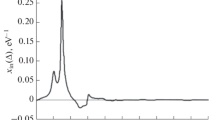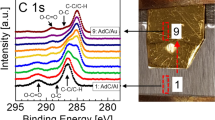Abstract
It is now well known that elastic photoelectron scattering in the surface region of solids cannot be ignored in the mathematical formalism of quantitative XPS. Elastic collisions may increase or decrease the photoelectron signal intensity, depending on the experimental configuration. Consequently, it is advisable to take into account these effects in calculations of the surface composition. In certain experimental geometries, the photoelectron intensity is practically unaffected by elastic scattering events (configurations defined by the so-called “Master Angle”), and in principle such geometries should be recommended for measurements. Unfortunately, they usually cannot be implemented in typical constructions of spectrometers. In the present paper, different procedures for estimating corrections for elastic scattering events are overviewed. The influence of these correction procedures has been illustrated on examples of AuAgCu and AuAgPdCu alloys. It turned out that elastic photoelectron collisions substantially decrease the signal intensities selected for analysis. However, they are diminished by roughly the same factor. As a consequence, the calculated surface composition is only slightly modified by the correction procedure. This effect may not be of general validity for all solids, and the algorithms for calculating the surface composition should have an option for including any elastic scattering effects. Further efforts are needed to improve the predictive formulas providing corrections for elastic scattering effects.
Similar content being viewed by others
References
C. J. Powell and A. Jablonski, Nucl. Instrum. Methods Phys. Res., Sect. A, 2009, 601, 54.
C. S. Fadley, R. J. Baird, W. Siekhaus, T. Novakov, and S. A. L. Bergstrom, J. Electron Spectrosc. Relat. Phenom. 1974, 4, 93.
I. S. Tilinin, A. Jablonski, and W. S. M. Werner, Prog. Surf. Sci., 1996, 52, 193.
W. S. M. Werner, Surf. Interface Anal., 2001, 31, 141.
D. Briggs and M. P. Seah (ed.), “Practical Surface Analysis: Auger and X-ray Photoelectron Spectroscopy”, 2nd ed., 1990, Vol. 1, Chap. 5, Wiley, Chichester.
D. Briggs and J. T. Grant (ed.), “Surface Analysis by Auger and X-ray Photoelectron Spectroscopy”, 2003, IM Publishers, Chichester.
P. J. Feibelman, Phys. Rev. B, 1973, 7, 2305.
O. A. Baschenko and V. I. Nefedov, J. Electron Spectrosc. Relat. Phenom., 1979, 17, 405.
O. A. Baschenko and V. I. Nefedov, J. Electron Spectrosc. Relat. Phenom., 1980, 21, 153.
O. A. Baschenko and V. I. Nefedov, J. Electron Spectrosc. Relat. Phenom., 1982, 27, 109.
A. Jablonski, Surf. Interface Anal., 1989, 14, 659.
C. J. Powell and A. Jablonski, J. Electron Spectrosc. Relat. Phenom., 2010, in press.
A. Jablonski and C. J. Powell, Phys. Rev. B, 1994, 50, 4739.
A. Jablonski, Surf. Interface Anal., 1995, 23, 29.
C. J. Powell and A. Jablonski, NIST Electron Effective-Attenuation-Length Database Ver. 1.1, Standard Reference Data Program Database 82, US Department of Commerce, 2003, National Institute of Standards and Technology, Gaithersburg, MD, http://www.nist.gov.
A. Jablonski and I. S. Tilinin, J. Electron Spectrosc. Relat. Phenom., 1995, 74, 207.
A. Jablonski, Surf. Sci., 1996, 364, 380.
A. Jablonski and C. J. Powell, J. Vac. Sci. Technol., A. 1997, 15, 2095.
M. P. Seah and I. S. Gilmore, Surf. Interface Anal., 2001, 31, 835.
S. Chandrasekhar, “Radiative Transfer”, 1960, Chap. 5, Dover Publications, New York.
C. J. Powell and A. Jablonski, J. Phys. Chem. Ref. Data, 1999, 28, 19.
S. Tanuma, C. J. Powell, and D. R. Penn, Surf. Interface Anal., 1991, 17, 911.
S. Tanuma, C. J. Powell, and D. R. Penn, Surf. Interface Anal., 1994, 21, 165.
I. S. Tilinin, Phys. Rev. A, 1995, 51, 3058.
A. Jablonski, Phys. Rev. B, 1998, 58, 16470.
A. Jablonski and C. J. Powell, Phys. Rev. B, 2007, 76, 085123.
S. Tanuma, C. J. Powell, and D. R. Penn, Surf. Interface Anal., 2003, 35, 268.
C. J. Powell and A. Jablonski, NIST Electron Inelastic-Mean-Free-Path Database, Version 1.1, Standard Reference Data Program Database 71, U.S. Department of Commerce, 2000, National Institute of Standards and Technology, Gaithersburg, MD, http://www.nist.gov.
W. Hanke, H. Ebel, M. F. Ebel, A. Jablonski, and K. Hirokawa, J. Electron Spectrosc. Relat. Phenom., 1986, 40, 241.
A. Jablonski, B. Lesiak, L. Zommer, M. F. Ebel, H. Ebel, Y. Fukuda, Y. Suzuki, and S. Tougaard, Surf. Interface Anal., 1994, 21, 724.
A. Jablonski, Surf. Interface Anal., 1993, 20, 317.
ISO 18115, Surface Chemical Analysis—Vocabulary, 2001, International Organisation for Standardisation, Geneva; ISO 18115, Surface Chemical Analysis—Vocabulary— Amendment 2, 2007, International Organisation for Standardisation, Geneva.
O. A. Baschenko, G. V. Machavariani, and V. I. Nefedov, J. Electron Spectrosc. Relat. Phenom., 1984, 34, 305.
A. Jablonski and J. Zemek, Phys. Rev. B, 1993, 48, 4799.
A. Jablonski and J. Zemek, Surf. Sci., 1997, 387, 288.
For more information, contact A. Jablonski, Institute of Physical Chemistry, Warsaw, Poland, e-mail: jablo@ichf. edu.pl.
A. Jablonski and C. J. Powell, Surf. Sci., 2010, in press.
A. Jablonski, F. Salvat, and C. J. Powell, J. Phys. Chem. Ref. Data, 2004, 33, 409.
Author information
Authors and Affiliations
Corresponding author
Rights and permissions
About this article
Cite this article
Jablonski, A. Determination of Surface Composition by X-ray Photoelectron Spectroscopy Taking into Account Elastic Photoelectron Collisions. ANAL. SCI. 26, 155–164 (2010). https://doi.org/10.2116/analsci.26.155
Received:
Accepted:
Published:
Issue Date:
DOI: https://doi.org/10.2116/analsci.26.155




